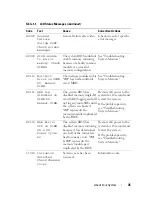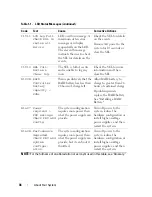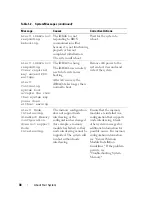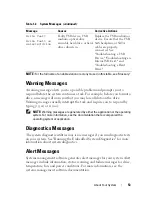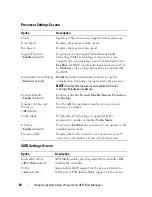
About Your System
45
No boot device
available
Faulty or missing optical
drive subsystem, hard drive,
or hard-drive subsystem, or
no bootable USB key
installed.
Use a bootable USB key, CD,
or hard drive. If the problem
persists, see
"Troubleshooting an Internal
SD Card," "Troubleshooting
a USB Device,"
"Troubleshooting an Optical
Drive," and "Troubleshooting
a Hard Drive." See "Using the
System Setup Program and
UEFI Boot Manager" for
information on setting the
order of boot devices.
No boot sector on
hard drive
Incorrect configuration
settings in System Setup
program, or no operating
system on hard drive.
Check the hard-drive
configuration settings in the
System Setup program. See
"Using the System Setup
Program and UEFI Boot
Manager." If necessary, install
the operating system on your
hard drive. See your
operating system
documentation.
No timer tick
interrupt
Faulty system board.
See "Getting Help."
PCI BIOS failed
to install
PCIe device BIOS (Option
ROM) checksum failure
detected during shadowing.
Cables to expansion card(s)
loose; faulty or improperly
installed expansion card(s).
Reseat the expansion card(s).
Ensure that all appropriate
cables are securely connected
to the expansion card(s). If
the problem persists, see
"Troubleshooting Expansion
Cards."
PCIe Training
Error: Expected
Link Width is
x
,
Actual Link Width
is
y
.
Faulty or improperly
installed PCIe card in the
specified slot.
Reseat the PCIe card in the
specified slot number. See
"Troubleshooting Expansion
Cards." If the problem
persists, see "Getting Help."
Table 1-2.
System Messages
(continued)
Message
Causes
Corrective Actions
Summary of Contents for PowerVault NX3000
Page 1: ...Dell PowerVault NX3000 Systems Hardware Owner s Manual ...
Page 180: ...180 Jumpers and Connectors ...
Page 182: ...182 Getting Help ...
Page 192: ...192 Glossary ...
Page 200: ...200 Index ...





